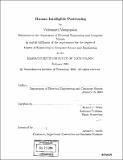Human intelligible positioning
Author(s)
Venugopalan, Vishwanath, 1981-
DownloadFull printable version (10.45Mb)
Other Contributors
Massachusetts Institute of Technology. Dept. of Electrical Engineering and Computer Science.
Advisor
Robert C. Miller.
Terms of use
Metadata
Show full item recordAbstract
We use street addresses to refer to locations in a city. Street addresses are easy to remember and communicate because they follow a symbolic addressing scheme, containing human intelligible symbols. However, street addresses can often be ambiguous or confusing and don't provide complete coverage of outdoor spaces. Latitude and longitude coordinates, a metric addressing scheme, are unambiguous and accommodate locations that may not have street addresses. However, latitude and longitude coordinates are unusable on a daily basis because they must be specified to many digits to be useful at human-level scales. This thesis describes the design and implementation of a new hybrid addressing scheme, Human Intelligible Positioning (HIP), which uses a metric addressing scheme as its substrate. Addresses in this metric addressing scheme are mapped to two-dimensional offsets within named coordinate systems. HIP addresses combine the easy memorability and communicability of street addresses with the precision and universal outdoor coverage of latitude and longitude coordinates.
Description
Thesis (M. Eng.)--Massachusetts Institute of Technology, Dept. of Electrical Engineering and Computer Science, 2004. Includes bibliographical references (p. 115-117).
Date issued
2004Department
Massachusetts Institute of Technology. Department of Electrical Engineering and Computer SciencePublisher
Massachusetts Institute of Technology
Keywords
Electrical Engineering and Computer Science.